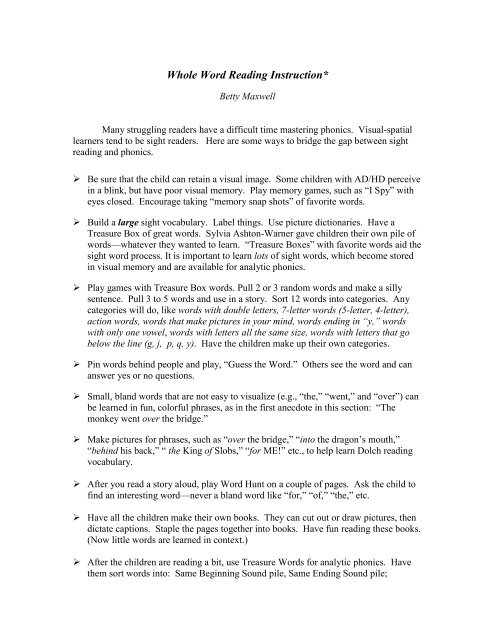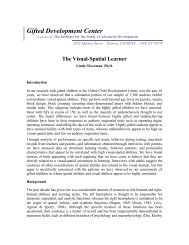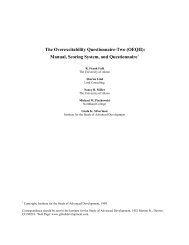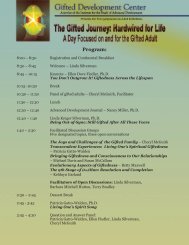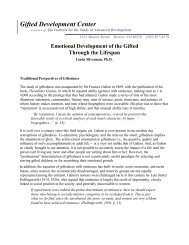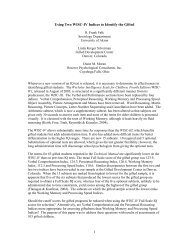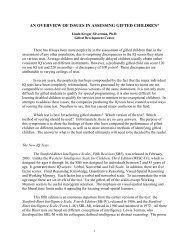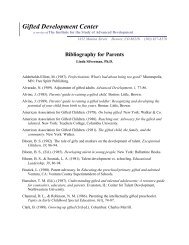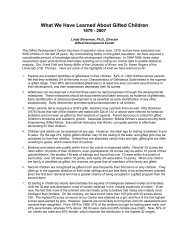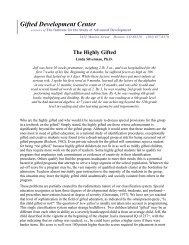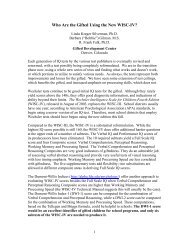Whole Word Reading Instruction* - the Gifted Development Center
Whole Word Reading Instruction* - the Gifted Development Center
Whole Word Reading Instruction* - the Gifted Development Center
Create successful ePaper yourself
Turn your PDF publications into a flip-book with our unique Google optimized e-Paper software.
<strong>Whole</strong> <strong>Word</strong> <strong>Reading</strong> <strong>Instruction*</strong>Betty MaxwellMany struggling readers have a difficult time mastering phonics. Visual-spatiallearners tend to be sight readers. Here are some ways to bridge <strong>the</strong> gap between sightreading and phonics.‣ Be sure that <strong>the</strong> child can retain a visual image. Some children with AD/HD perceivein a blink, but have poor visual memory. Play memory games, such as “I Spy” wi<strong>the</strong>yes closed. Encourage taking “memory snap shots” of favorite words.‣ Build a large sight vocabulary. Label things. Use picture dictionaries. Have aTreasure Box of great words. Sylvia Ashton-Warner gave children <strong>the</strong>ir own pile ofwords—whatever <strong>the</strong>y wanted to learn. “Treasure Boxes” with favorite words aid <strong>the</strong>sight word process. It is important to learn lots of sight words, which become storedin visual memory and are available for analytic phonics.‣ Play games with Treasure Box words. Pull 2 or 3 random words and make a sillysentence. Pull 3 to 5 words and use in a story. Sort 12 words into categories. Anycategories will do, like words with double letters, 7-letter words (5-letter, 4-letter),action words, words that make pictures in your mind, words ending in “y,” wordswith only one vowel, words with letters all <strong>the</strong> same size, words with letters that gobelow <strong>the</strong> line (g, j, p, q, y). Have <strong>the</strong> children make up <strong>the</strong>ir own categories.‣ Pin words behind people and play, “Guess <strong>the</strong> <strong>Word</strong>.” O<strong>the</strong>rs see <strong>the</strong> word and cananswer yes or no questions.‣ Small, bland words that are not easy to visualize (e.g., “<strong>the</strong>,” “went,” and “over”) canbe learned in fun, colorful phrases, as in <strong>the</strong> first anecdote in this section: “Themonkey went over <strong>the</strong> bridge.”‣ Make pictures for phrases, such as “over <strong>the</strong> bridge,” “into <strong>the</strong> dragon’s mouth,”“behind his back,” “ <strong>the</strong> King of Slobs,” “for ME!” etc., to help learn Dolch readingvocabulary.‣ After you read a story aloud, play <strong>Word</strong> Hunt on a couple of pages. Ask <strong>the</strong> child tofind an interesting word—never a bland word like “for,” “of,” “<strong>the</strong>,” etc.‣ Have all <strong>the</strong> children make <strong>the</strong>ir own books. They can cut out or draw pictures, <strong>the</strong>ndictate captions. Staple <strong>the</strong> pages toge<strong>the</strong>r into books. Have fun reading <strong>the</strong>se books.(Now little words are learned in context.)‣ After <strong>the</strong> children are reading a bit, use Treasure <strong>Word</strong>s for analytic phonics. Have<strong>the</strong>m sort words into: Same Beginning Sound pile, Same Ending Sound pile;
Rhyming <strong>Word</strong>s; Silent E words; etc. Can <strong>the</strong>y make a silly sentence or tonguetwister out of some of <strong>the</strong> words?‣ Discover word patterns. These will often be rhymes. On <strong>the</strong> board, play gamessubstituting beginning or ending sounds. Ra<strong>the</strong>r than teach short vowel sounds(which are hard for VSLs to learn), teach a rhyming word or <strong>the</strong> same word “family.”Remember that <strong>the</strong>se children are good at recognizing patterns, love seeingrelationships, have a superb sense of rhythm, but are poor at memorization.‣ Teach consonant blends through silly tongue twisters: “Please play on <strong>the</strong> planet,Pluto.” “Greedy Greta eats green grapes.” “Spray <strong>the</strong> Spruce with sprinkles in <strong>the</strong>spring.” Read <strong>the</strong> Dr. Seuss alphabet book to <strong>the</strong> children, <strong>the</strong>n have <strong>the</strong>m make uptongue twisters of <strong>the</strong>ir own.‣ Teach Greek and Latin roots, prefixes and affixes. See if <strong>the</strong>y can find <strong>the</strong>se parts ofwords in <strong>the</strong> additives on cereal boxes, in dictionaries, in books with Latin names ofanimals and insects, in medical books, at <strong>the</strong> zoo or botanical garden.‣ Accompany reading with visualization techniques to assist children in learning tospell words <strong>the</strong>y want to use in <strong>the</strong>ir creative writing. (See “A Visualization Approachto Spelling” after <strong>the</strong> section on reading.)*From Silverman, L. K. (2002). Upside-Down Brilliance: The Visual-SpatialLearner. Denver: DeLeon Publishing.


